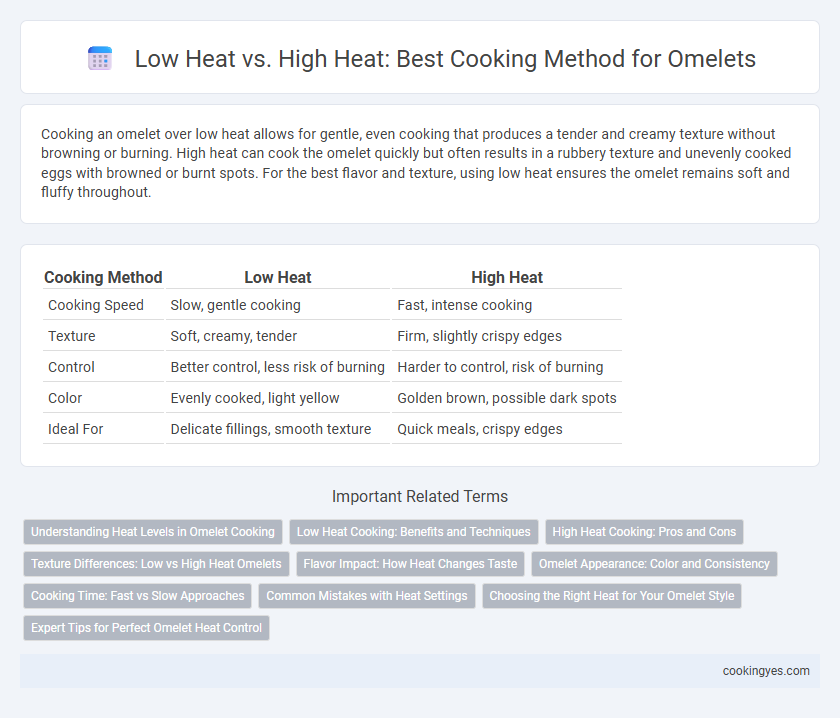Cooking an omelet over low heat allows for gentle, even cooking that produces a tender and creamy texture without browning or burning. High heat can cook the omelet quickly but often results in a rubbery texture and unevenly cooked eggs with browned or burnt spots. For the best flavor and texture, using low heat ensures the omelet remains soft and fluffy throughout.
Table of Comparison
| Cooking Method | Low Heat | High Heat |
|---|---|---|
| Cooking Speed | Slow, gentle cooking | Fast, intense cooking |
| Texture | Soft, creamy, tender | Firm, slightly crispy edges |
| Control | Better control, less risk of burning | Harder to control, risk of burning |
| Color | Evenly cooked, light yellow | Golden brown, possible dark spots |
| Ideal For | Delicate fillings, smooth texture | Quick meals, crispy edges |
Understanding Heat Levels in Omelet Cooking
Cooking an omelet on low heat allows for gentle, even cooking that prevents browning and preserves a tender texture, ideal for fluffy, smooth results. High heat causes rapid cooking and can create a crispy, browned exterior but risks overcooking or burning the eggs inside. Understanding the balance between low and high heat ensures the perfect omelet, optimizing both texture and flavor.
Low Heat Cooking: Benefits and Techniques
Cooking an omelet on low heat ensures even cooking and prevents browning or burning, preserving a tender, creamy texture. This method allows proteins to set gradually, resulting in a fluffier omelet with enhanced moisture retention. Mastering low heat techniques, such as slow stirring and gentle folding, improves control over texture and flavor development.
High Heat Cooking: Pros and Cons
High heat cooking rapidly sets the eggs, creating a slightly crispy exterior while maintaining a soft interior, ideal for a fluffy and textured omelet. However, high temperatures increase the risk of uneven cooking, with potential for browning or burning, which can result in a bitter taste. Mastering high heat requires quick attention and proper pan selection to achieve optimal omelet texture and flavor.
Texture Differences: Low vs High Heat Omelets
Cooking an omelet on low heat results in a tender, creamy texture due to the gentle coagulation of eggs, preserving moisture and preventing browning. High heat creates a firmer, slightly crispy exterior while risking a rubbery interior from rapid protein tightening. Low heat is ideal for a delicate, fluffy consistency, whereas high heat suits those preferring a more robust, golden-browned surface.
Flavor Impact: How Heat Changes Taste
Cooking an omelet over low heat allows proteins to cook gently, preserving moisture and producing a tender, creamy texture that enhances subtle flavors. High heat results in faster cooking but can cause browning or slight charring, introducing caramelized, robust flavors and a firmer texture. The choice between low and high heat directly influences the omelet's flavor profile by balancing moisture retention with Maillard reaction developments.
Omelet Appearance: Color and Consistency
Cooking an omelet on low heat results in a tender texture with a consistent pale yellow color, minimizing browning and preserving a smooth, creamy interior. High heat produces a darker, golden-brown exterior with potential for uneven cooking and a firmer, sometimes rubbery consistency. Achieving a visually appealing omelet requires balancing heat to maintain even color and a soft, fluffy texture.
Cooking Time: Fast vs Slow Approaches
Cooking an omelet on low heat results in a slower cooking time which allows the eggs to cook evenly and develop a tender, creamy texture. High heat accelerates the cooking process, producing a faster omelet but increases the risk of browning or burning the edges while leaving the center undercooked. Optimal control of heat ensures the perfect balance between cooking speed and omelet quality, with many chefs preferring low heat for a consistently soft and fluffy omelet.
Common Mistakes with Heat Settings
Cooking an omelet on high heat often results in a burnt exterior and undercooked interior, while low heat can produce a rubbery texture due to prolonged cooking. Common mistakes include setting the stove too high, which causes uneven cooking and browning, or too low, leading to sogginess and loss of fluffiness. Optimal heat control--moderate to low--ensures a tender, evenly cooked omelet with a smooth, creamy consistency.
Choosing the Right Heat for Your Omelet Style
Cooking an omelet on low heat ensures even cooking and a tender, creamy texture ideal for fluffy or custard-style omelets, while high heat quickly browns the exterior, creating a crispy, golden finish suitable for more robust, skillet-style omelets. Selecting the right heat depends on desired texture and cooking time, with low heat favoring control and uniformity and high heat delivering speed and a slightly caramelized flavor. Mastering heat control enhances the overall taste and presentation of the omelet, aligning with various recipe styles and ingredient combinations.
Expert Tips for Perfect Omelet Heat Control
Cooking an omelet over low heat ensures gentle, even cooking, preventing browning and preserving a tender texture. Using high heat can cause the eggs to cook too quickly, resulting in a rubbery, overcooked omelet with uneven consistency. Expert chefs recommend starting on medium-low heat and adjusting as needed to achieve a silky, fluffy omelet with optimal moisture retention.
Low Heat vs High Heat for omelet cooking method Infographic

 cookingyes.com
cookingyes.com